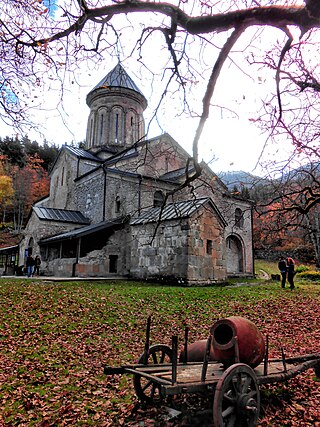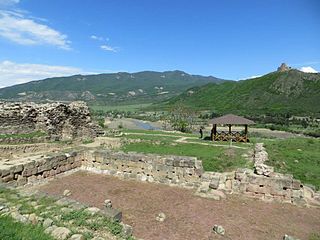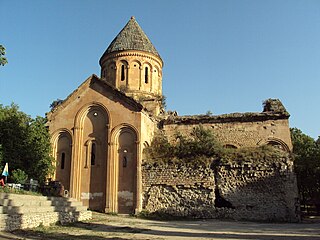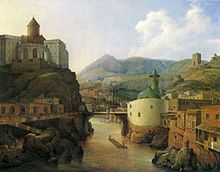
The Georgian Soviet Socialist Republic, also known as Soviet Georgia, the Georgian SSR, or simply Georgia, was one of the republics of the Soviet Union from its second occupation in 1921 to its independence in 1991. Coterminous with the present-day republic of Georgia, it was based on the traditional territory of Georgia, which had existed as a series of independent states in the Caucasus prior to the first occupation of annexation in the course of the 19th century. The Georgian SSR was formed in 1921 and subsequently incorporated in the Soviet Union in 1922. Until 1936 it was a part of the Transcaucasian Socialist Federative Soviet Republic, which existed as a union republic within the USSR. From November 18, 1989, the Georgian SSR declared its sovereignty over Soviet laws. The republic was renamed the Republic of Georgia on November 14, 1990, and subsequently became independent before the dissolution of the Soviet Union on April 9, 1991, whereupon each former SSR became a sovereign state.

Mtskheta is a city in the region of Mtskheta-Mtianeti, Georgia. It is one of the oldest cities in Georgia as well as one of the oldest continuously inhabited cities in the world. It is located approximately 20 km (12 mi) north of Tbilisi, at the confluence of the Mtkvari and Aragvi rivers. Currently a small provincial capital, for nearly a millennium until the 5th century AD, Mtskheta was a large fortified city, a significant economical and political centre of the Kingdom of Iberia.

Narikala is an ancient fortress overlooking Tbilisi, the capital of Georgia, and the Mtkvari (Kura) River. The fortress consists of two walled sections on a steep hill between the sulfur baths and the botanical gardens of Tbilisi. On the lower court there is the recently restored St Nicholas church. Newly built in 1996–1997, it replaces the original 13th-century church that was destroyed in a fire. The new church is of "prescribed cross" type, having doors on three sides. The internal part of the church is decorated with the frescos showing scenes from both the Bible and the history of Georgia.

Vakhtang I Gorgasali, of the Chosroid dynasty, was a king (mepe) of Iberia, natively known as Kartli in the second half of the 5th and first quarter of the 6th century.

Vakhtang VI, also known as Vakhtang the Scholar, Vakhtang the Lawgiver and Ḥosaynqolī Khan, was a Georgian monarch of the royal Bagrationi dynasty. He ruled the East Georgian Kingdom of Kartli as a vassal of Safavid Persia from 1716 to 1724. One of the most important and extraordinary statesman of early 18th-century Georgia, he is known as a notable legislator, scholar, critic, translator and poet. His reign was eventually terminated by the Ottoman invasion following the disintegration of Safavid Persia, which forced Vakhtang into exile in the Russian Empire. Vakhtang was unable to get the tsar's support for his kingdom and instead had to permanently stay with his northern neighbors for his own safety. On his way to a diplomatic mission sanctioned by Empress Anna, he fell ill and died in southern Russia in 1737, never reaching Georgia.

Kintsvisi Monastery is a Georgian Orthodox monastery in the Shida Kartli region, eastern Georgia, 10 kilometers from the town Kareli, on a forested slope of a high mountain of the Dzama valley. Its main church is an exceptional example of a brick church from the Georgian Golden Age period. The monumental mural is one of the largest among the Medieval Georgian artistic ensembles.

Alexander I the Great, of the Bagrationi house, was king (mepe) of Georgia from 1412 to 1442. Despite his efforts to restore the country from the ruins left by the Turkomans warlords and Timur's invasions, Georgia never recovered and faced the inevitable fragmentation that was followed by a long period of stagnation. Alexander was the last ruler of a united Georgia which was relatively free from foreign domination. In 1442, he abdicated the throne and retired to a monastery.

Dimitri Shevardnadze was a Georgian painter, art collector and intellectual purged during Joseph Stalin's repressions.

The Sioni Cathedral of the Dormition is a Georgian Orthodox cathedral in Tbilisi, the capital of Georgia. Following a medieval Georgian tradition of naming churches after particular places in the Holy Land, the Sioni Cathedral bears the name of Mount Zion at Jerusalem. It is commonly known as the "Tbilisi Sioni" to distinguish it from several other churches across Georgia bearing the name Sioni.

The Svetitskhoveli Cathedral is an Orthodox Christian cathedral located in the historic town of Mtskheta, Georgia, to the northwest of the Georgian capital Tbilisi. A masterpiece of the Early and High Middle Ages, Svetitskhoveli is recognized by UNESCO as a World Heritage Site. It is currently the second largest church building in Georgia, after the Holy Trinity Cathedral.

The history of Tbilisi, the capital of Georgia, dates back to at least the 5th century AD. Since its foundation by the monarch of Georgia's ancient precursor Kingdom of Iberia, Tbilisi has been an important cultural, political and economic center of the Caucasus and served, with intermissions, as the capital of various Georgian kingdoms and republics. Under the Russian rule, from 1801 to 1917 it was called Tiflis and held the seat of the Imperial Viceroy governing both sides of the entire Caucasus.

Armazi is a locale in Georgia, 4 km southwest of Mtskheta and 22 km northwest of Tbilisi. A part of historical Greater Mtskheta, it is a place where the ancient city of the same name and the original capital of the early Georgian kingdom of Kartli or Iberia was located. It particularly flourished in the early centuries AD and was destroyed by the Arab invasion in the 730s.

The Kldisubani St. George Church or Qarapi Saint Gevorg church is an 18th-century church at the foot of the Narikala citadel in Old Tbilisi, Georgia. The church is single-naved and was built in 1753. The Georgian Orthodox Church was built on the site of an ancient Georgian church which was built during the reign of St. King Vakhtang I of Iberia. The church was reconstructed with the help of Armenian merchant Petros Zohrabian and his wife Lolita and the restoration held by them in 1735, what makes the church one of the most important examples of Georgian-Armenian friendship and cooperation.

Ishkani or Ishkhan, is a ruined Christian monastery in the territory of Turkey in the village of İşhan, Artvin province. The name Ishkhani derives from the word “Իշխան” (Ishkhan) which means “prince” in the Armenian language. It was one of the important spiritual centers in the Middle Ages Tayk/Tao-Klarjeti. Only the magnificent church and the adjacent chapel have survived. The earliest mention of the monastery is found in The Life of Grigol Khandzteli, a Georgian manuscript dating from the year 951, which is now kept in Jerusalem.

Mariam Dadiani was a daughter of Manuchar I Dadiani, Prince of Mingrelia, by his second wife, Tamar Jaqeli. Thrice married, successively to Simon I Gurieli, Prince of Guria, in 1621, King Rostom of Kartli in 1638, and the latter's adopted son and successor, King Vakhtang V in 1658.

The Lurji Monastery, that is the "Blue Monastery", is a 12th-century Georgian Orthodox church built in the name of Saint Andrew in the Vere neighborhood of Tbilisi, Georgia. The popular historical name lurji ("blue") is derived from its roof, adorned with glazed blue tile.

The Atsquri church of the Dormition is a ruined medieval cathedral in the village of Atsquri, Akhaltsikhe Municipality, in Georgia's south-central region of Samtskhe-Javakheti. Originally built in the 10th–11th century, the church was rebuilt shortly after the destructive earthquake of 1283. It was a crossed-dome church with three protruding apses on the east. Of what was one of the largest cathedrals in Georgia in its time, only ruined walls survived into the 21st century. A project of full restoration was launched in 2016. The church is inscribed on the list of the Immovable Cultural Monuments of National Significance of Georgia.

The Virgin Mary Assumption Church of Metekhi, known simply as Metekhi, is a Georgian Orthodox Christian church located on the left bank of the river Kura. It sits on the Metekhi Cliff opposite the old town of Tbilisi. Much of the existing structure dates back to the Middle Ages and was built between 1278 and 1289 AD under the reign of King Demetrius II of Georgia, although oral tradition traces Metekhi's origins further to the 5th century.

The Cheremi historic site is a historic and archaeological site in eastern Georgia, situated in and around the modern village of Cheremi, Gurjaani Municipality, in the region of Kakheti. The site encompasses the ruins of churches, a castle with a circuit wall, and burials. Parts of these ruins correspond to the extinct town of Cheremi known from the early medieval Georgian chronicles and are inscribed on the list of the Immovable Cultural Monuments of National Significance.

Aghaiani church of Saint Nino is an early medieval Georgian Orthodox church on Mount Tkhoti, 2 km southeast of the village of Aghaiani in the Kaspi Municipality in Georgia's Shida Kartli region. It stands at the place of one of the three wooden crosses erected—according to historical tradition—at the behest of Saint Nino to mark adoption of Christianity by the people of Kartli. The extant structure is a hall church, a 9th–10th-century remodeling of an earlier cross-in-square building. The church is inscribed on the list of Georgia's Immovable Cultural Monuments of National Significance.
























